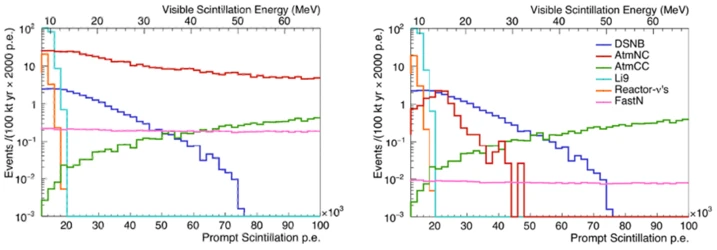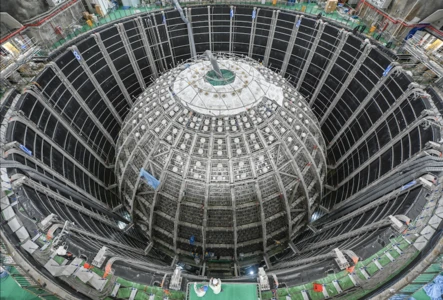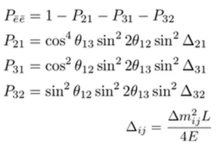JUNO
JUNO is an international collaboration involving more than 700 physicists, mainly based in China, with significant European participation. The name JUNO stands for Jiangmen Underground Neutrino Observatory, with Jiangmen referring to the location in China where the experiment is being built. The centerpiece of the project is a spherical 20-ton liquid scintillation detector (see Fig. 1), which was completed in 2025 and is 20 times larger than previous detectors of its kind. It is instrumented with approximately 18,000 PMTs with a diameter of 20" and 25,000 smaller ones with 3’’ diameter. Together with an ultra-high-performance scintillator, this guarantees a breakthrough in energy resolution. The realized ~ 3% at 1MeV, were unprecedented for this type of detector. The central detector is surrounded by a water Cherenkov veto with around 2,000 PMTs, which will enable the identification of particles from cosmic rays that would otherwise represent background noise for the actual experiment. In order to keep this background source as low as possible JUNO is located deeply underground below a 700 m rock cover.
The main goal of JUNO is to determine the mass ordering of neutrinos using reactor neutrinos. Therefore, the location of the underground laboratory was chosen so that it is equidistant from two very powerful nuclear power plant complexes. The distance of 53 km was selected so that the expected oscillation effect of the neutrinos is maximized with respect to the solar oscillation parameters. This will make it possible to measure these parameters with a precision of less than 1% and maximize the sensitivity of the experiment to the mass ordering. In addition, the detector is also ideal for observing neutrinos from astrophysical sources. Further details on the physics program can be found within the following sections.
Determination of the mass ordering of neutrinos
The first part, P21, is dominant and describes an oscillation governed solely by solar oscillation parameters. The result can be seen as a solid black line in the oscillated spectrum of the reactor neutrinos at JUNO shown below (Fig. 2). The next two terms have only slightly different amplitudes and therefore cannot be clearly separated from each other, but they interfere with each other. However, since P31 depends on Dm231 and P32 depends on Dm232, the oscillation frequencies differ. Which of the two frequencies is higher depends in turn on the mass ordering. This results in the subdominant fine oscillation pattern, which can be seen in the spectrum below (Fig. 2) as a blue or red line, with the color code indicating the different mass orderings – blue for the normal ordering and red for the inverse one.
In order to resolve this subdominant structure and thus distinguish between the two possible mass orderings, particularly good energy resolution is required for neutrino detection. With the energy resolution of 3% at 1 MeV neutrino energy realized by JUNO, a significance of 3 to 4 sigma is ensured within the next decade.
Precision measurements of neutrino oscillation parameters
With the completion of JUNO a new aera of high-precision reactor neutrino physics begins. Today, most of the parameters in the PMNS matrix have been measured with a precision better than 5% (see Table 1). With JUNO world-leading sub-percent measurements are feasible already in the first year of data taking. In addition to the determination of the neutrino mass ordering this yet unprecedented precision opens up new possibilities for fundamental tests of the 3-flavor paradigm in the neutrino sector. By testing the unitarity of the 3x3 PMNS matrix, conclusions can be drawn for the existence of hidden neutrino flavors.
| Parameter | Central Value | Current Precision | 100 days | 6 years | 20 years |
| ∆m231(× 10−3 eV2) | 2.5283 | ± 0.034 (1.3%) | ± 0.021 (0.8%) | ± 0.0047 (0.2%) | ± 0.0029 (0.1%) |
| ∆m221(× 10−5 eV2) | 7.53 | ± 0.18 (2.4%) | ± 0.074 (1.0%) | ± 0.024 (0.3%) | ± 0.0017 (0.2%) |
| sin2 θ12 | 0.307 | ± 0.013 (4.2%) | ± 0.0058 (1.9%) | ± 0.0016 (0.5%) | ± 0.0010 (0.3%) |
| sin2 θ13 | 0.0218 | ± 0.0007 (3.2%) | ± 0.010 (47.9%) | ± 0.0026 (12.1%) | ± 0.0016 (7.3%) |
Table 2: Summary of precision levels for some oscillation parameters. The current knowledge as reported by Particle Data Group (PDG) is compared with 100 days, 6 years, and 20 years of data taking with JUNO and JUNO-TAO. No external constraint on sin2θ13 is applied for these results.
Geo-neutrinos
One unsolved problem in geophysics is the question of how exactly the heat emitted by the Earth is produced. To answer this question, it is necessary to estimate the distribution, quantity, and isotope abundance of natural radioisotopes in the Earth's interior, as their decay energy contributes to the Earth's heat balance. The KamLAND and Borexino experiments have already provided initial evidence of geo-neutrinos. However, with a relative error of 25-30% on the total amount of geo-neutrinos, these measurements are not yet sufficient to distinguish between the most important geophysical models for geo-neutrinos. With an expected error of around 17%, JUNO will contribute to a better understanding in this area. In addition, the JUNO detector is located in a completely different geological environment than the other two experiments, so that valuable information about the distribution of radioisotopes as a function of the surrounding geology will be obtained in any case. Another goal is to determine the ratio of geoneutrinos originating from isotopes of the uranium series to those originating from the thorium series. Thanks to the high number of geoneutrinos compared to previous experiments, it may also be possible to distinguish which proportion of neutrinos originate from the Earth's crust and which from its mantle. All of this would help to improve geological models of the Earth, especially since neutrinos offer a unique opportunity to look into deeper layers of the Earth.
Supernova neutrinos
Massive stars end their life cycle after consuming the fuel in their core through a chain of fusion processes, ultimately producing iron, by means of a gravitational collapse that leads to a supernova. In this type of supernova, 99% of the energy released is emitted in the form of neutrinos. According to current thinking, these neutrinos also contribute significantly to the course and successful explosion of a supernova, for example by carrying energy from the interior of the core to the outside, causing it to heat up.
Statistically speaking, such an event occurs within our galaxy every few decades. This means that it is an event that can be observed about once in a lifetime. The average expected distance of such a galactic supernova from Earth is 10 kpc. For a supernova at this distance, the JUNO detector would register about 5,000 neutrino events within a few seconds. The temporal evolution of this neutrino burst, the energy spectrum, and the flavor composition of the neutrino flux can then be used to draw valuable conclusions about the mechanisms of supernovae and the formation of heavy elements during a supernova. In addition, information about the properties of the neutrinos themselves is also contained, including the mass ordering, the magnetic properties of the neutrinos, and potentially new physics.
The Diffuse Supernova Neutrino Background (DSNB)
The combined neutrino flux of all supernovae to date is called the diffuse supernova background. It can provide information about the star formation rate, the average neutrino spectrum of a supernova, and the rate of incompletely ignited supernovae. The primary detection channel is the inverse beta decay of electron antineutrinos. The spectra expected in JUNO (blue line in Fig. 3) can be seen in the figure below. The left plot shows the expected signal and backgrounds without pulse shape analysis, and the right graph shows them after the background has been reduced by means of pulse shape analysis. The blue line shows the current theoretical flux for an average neutrino energy of 15 MeV.

Solar neutrinos
One of the most important steps towards the discovery of neutrino oscillation was undoubtedly the solution of the solar neutrino puzzle by the SNO experiment. This experiment showed that the measured neutrino flux from the Sun is consistent with theoretical predictions when all neutrino types are considered, but that there is a deficit when only electron neutrinos are considered (Nobel Prize 2015). In the meantime, the Borexino detector has been able to measure large parts of the solar neutrino spectrum (see next figure below), thereby confirming both the neutrino oscillations of solar neutrinos and the Standard Model of the Sun. However, one particularly important questions remain unanswered.
On the other hand, it has been possible to determine the oscillation probability for solar neutrinos at neutrino energies below 1 MeV, where the results are consistent with neutrino oscillation in a vacuum. This has also been measured for energies above 3 MeV, where the results are consistent with neutrino oscillation dominated by the MSW effect. Between these two energy ranges, a continuous transition of the oscillation probability is expected, the shape of which should be characteristic of the MSW effect. Measurement of the 8B neutrino spectrum in this energy range could therefore clarify the question of the validity of the MSW effect. However, due to the optimization of the experiment for reactor neutrinos and the rather small overburden of 700m in JUNO’s underground laboratory, the solar neutrino spectrum will be overlaid by background signals. For this reason, precise knowledge of the background and techniques for reducing it are necessary. This concerns, on the one hand, contamination of the detector by radionuclides and, on the other hand, cosmogenic radionuclides. First studies of the intrinsic radiopurity of the liquid scintillator in 2025 are showing highly promising results of excellent low contaminations!
Atmospheric neutrinos
Atmospheric neutrinos, i.e. those produced by lepton decay of cosmic ray particles, played a prominent role in the discovery of neutrino oscillation, as did neutrinos from the Sun. The Super-Kamiokande detector observed that the ratio of atmospheric electron and muon neutrinos depends on the distance they travel in the Earth's atmosphere after their creation before reaching the detector. This can be explained by neutrino oscillations. Due to the long flight distance through the Earth, the matter effect has a measurable influence on the observed oscillation probabilities. For this reason, it is possible to determine the mass ordering of neutrinos using atmospheric neutrinos with a sufficiently large detector that also has good angular and energy resolution. Ice-Cube Upgrade and similar detectors are pursuing this concept.
In principle, JUNO is also suitable for this measurement. However, due to the relatively small mass of the JUNO detector (compared to Ice-Cube Upgrade), only a low significance of about 1.5s is expected for this measurement in JUNO. However, due to the complementarity of this method for determining the mass ordering with reactor neutrinos, it has a high potential to significantly improve the overall significance of the JUNO experiment on the mass ordering. In addition, the potential to obtain information from atmospheric neutrinos in JUNO would increase significantly if modern reconstruction methods were used to determine the charge of muons stopped in liquid scintillator.
Proton decay
In order to explain the observed asymmetry between matter and antimatter in our universe, baryon number conservation must be violated. Therefore, in many Grand Unification Theories (GUTs), unlike in the Standard Model, baryon number is only approximately conserved, allowing these theories to make predictions about the lifetime of the proton. Thus, the study of proton decay offers an opportunity to both experimentally test GUTs and move one step closer to solving the baryon asymmetry problem.
For this reason, a whole series of experiments have been designed specifically to search for proton decay. The best known of these is Super-Kamiokande, which gained fame through its role in neutrino physics. One of the two most studied decay modes is the decay into a K+ and an antineutrino. Since the kaon in this case remains below the Cherenkov threshold in water, its detection in water Cherenkov detectors is hindered. This does not apply to liquid scintillation detectors, so that for JUNO a sensitivity limit on the half-life of the proton in this channel of 1.9x1034 years is calculated. This is three times better than the current world-best limit from Super-Kamiokande and approaches the range of interest for many GUTs.
New physics and the search for dark matter
In JUNO, the hunt for new physics includes the search for neutrinos that may originate from annihilation processes of dark matter in the sun. In addition, the spectrum of reactor neutrinos can be used to search for deviations from predictions for neutrino oscillations with three neutrino types. In this way, conclusions can be drawn about possible non-unitarity of the lepton mixing matrix, non-standard interactions, and a possible violation of Lorentz invariance.
Contact
For collaboration, thesis opportunities, or further inquiries, please contact:
Dr. rer. nat. Hans Steiger
- Tel.: +49 (89) 289 - 51320
- hans.steiger@tum.de


